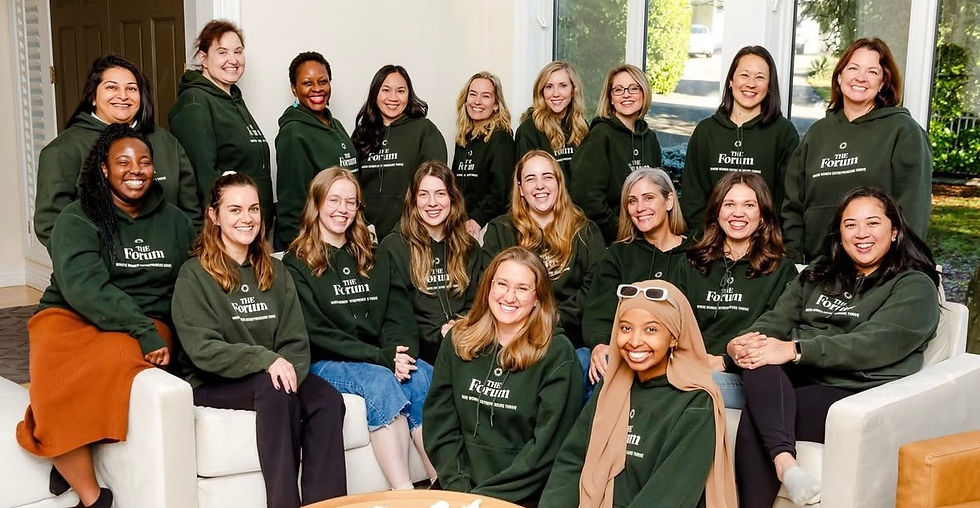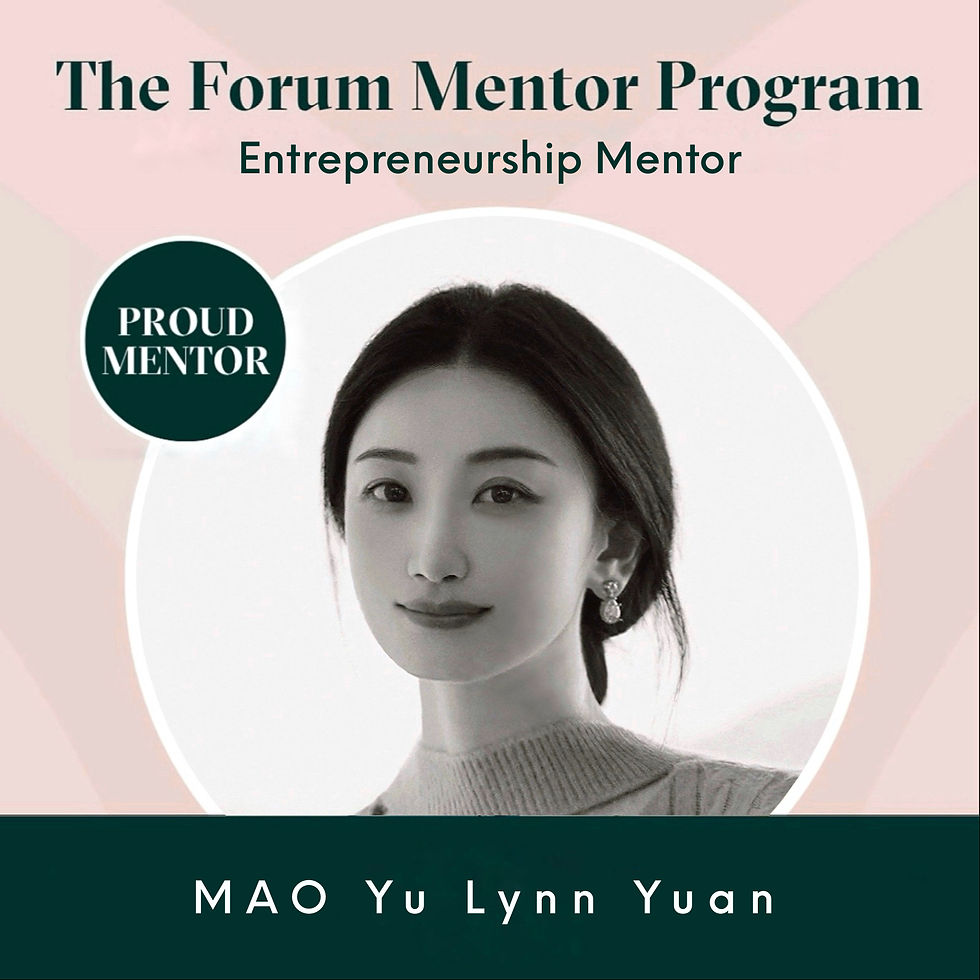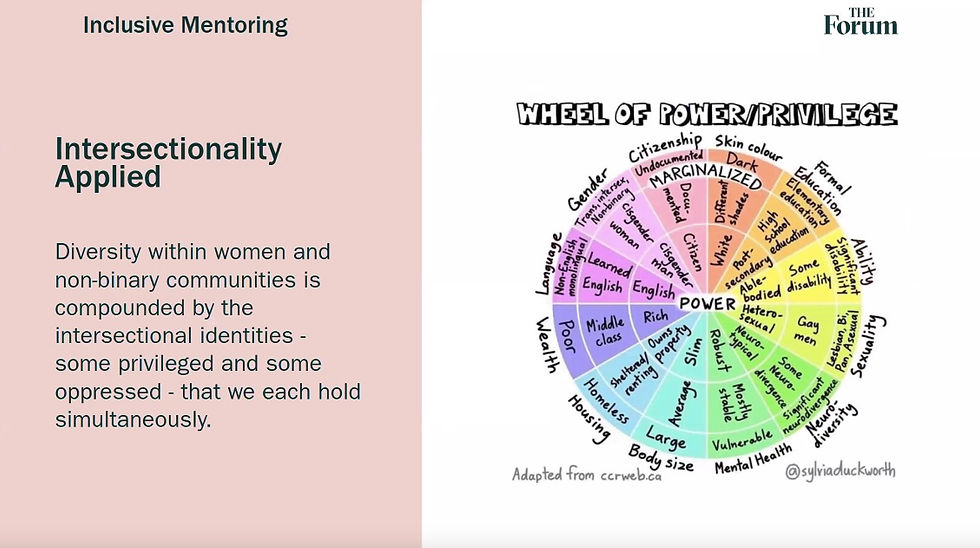Mao Yu Lynn Yuan Appointed as Women Entrepreneurship Mentor at Canadian Nonprofit The FORUM
- Editor

- Aug 13
- 8 min read
Updated: Sep 24
August 14, 2025 (Toronto, Canada) - FANIQUE, a multinational enterprise focused on building sustainable value through innovative projects, forged a strategic partnership in August 2025 with The FORUM, a public charity funded by Innovation, Science and Economic Development Canada (ISED). The two parties will integrate FANIQUE’s international innovation resources in fashion, lifestyle, and technology with The FORUM’s platform resources for supporting women’s entrepreneurship, offering women entrepreneurs enhanced educational resources, mentorship, funding, and networking opportunities. MAO Yu Lynn Yuan, founder of FANIQUE, officially assumed the role of Entrepreneurship Mentor at The FORUM starting in August 2025.
MAO Yu Lynn Yuan stated, “Since our strategic realignment in 2024, FANIQUE has remained focused on ‘Building Sustainable Values.’ Beyond pursuing profit, we also prioritize positive impacts on people and the planet — this is precisely the ‘Triangle Business Value Framework (3P Triangle: Profit, People, Planet)’ we advocate. Currently, the ‘Women Impact Initiative’ and ‘Sustainable AI for Good’ public-benefit projects, co-launched with our non-governmental organization partner, the Global Innovation and Sustainability Leadership Institution (GISLI, Hong Kong SAR, China), have been integrated into our long-term development strategy. This collaboration with The FORUM to empower women entrepreneurs is also a pivotal practice of this vision. We aim to amplify the positive influence of all stakeholders through this partnership, providing stronger support, resources, and opportunities for more women-led or women-focused entrepreneurial ventures.”



The FORUM, a public welfare platform funded by Innovation, Science and Economic Development Canada, has long specialized in nurturing women entrepreneurs and related innovative projects. Its flagship program, The Forum Pitch, is a renowned women’s entrepreneurship roadshow initiative in Canada. With a community-driven approach, it connects entrepreneurs with investors, industry leaders, and experts, enhances their practical capabilities and growth potential, and addresses financing challenges directly. Open to all Canadian women entrepreneurs planning to secure funding within 12 months, the program offers finalists prizes of tens of thousands of Canadian dollars plus additional award support. This collaboration will deepen the development of related innovative projects, incorporating FANIQUE’s pioneering concepts in innovation and sustainability to foster more sustainable ventures that align with the “Triangle Business Value Framework” and balance impacts on profit, people, and the planet.
Since its founding in 2013, FANIQUE has continuously advanced cross-sector innovation, launching projects such as FANIQUE magazine (Print ISSN 2369-792X; Digital ISSN 2369-7318), creating online-offline experiential shopping models, incubating tech-driven smart lifestyle brands, and building the F sustainable ecosystem platform business model. From 2019 to 2023, its FANIQUE Innovator Program — focused on youth employment — cultivated over 300 innovators from diverse international cultural backgrounds, partnering with more than 50 universities and educational institutions across North America (Canada and the United States).
The public charity The FORUM introduced the core tool for Inclusive Mentoring—the Wheel of Power/Privilege—during the mentor onboarding meeting. This tool is based on the theory of Intersectionality, concretizing the complex interactions of social identities. It helps people understand how multiple identities shape the experience of gaining privileges and facing oppression, focusing on exploring the profound impact of identity overlap on an individual’s social status.
The Wheel of Power/Privilege is essentially a “deconstructive tool” for the social power structure. Through visual presentation, it transforms abstract “discrimination and privilege” into a perceivable and analyzable specific framework. It does not create identity opposition but takes “visualization of systematic injustice” as a path to promote society to see the complex dilemmas of identity intersection, providing a cognitive basis for more precise and inclusive social change—only by deeply understanding the complexity of identity intersection can we truly move towards the construction of an equal society.

I. Design Logic and Core Concepts
The Wheel of Power/Privilege is constructed based on the theory of Intersectionality. It emphasizes that an individual’s identity is not a simple collection of single labels but an overlapping entity of multiple identities such as gender, race, class, and sexual orientation. These identities simultaneously generate “Privilege-granting” and “Marginalization-imposing” effects within the social structure. Through visual classification, the wheel clearly presents two core identity spectrums:
Power-aligned - Advantaged identities (such as white people, wealthy groups, etc.) in the inner layer of the wheel, relying on existing social rules, can more easily obtain resource distribution, social respect, and development opportunities, and are “natural beneficiaries” of the social privilege system.
Marginalized - Disadvantaged identities (such as undocumented immigrants, people of color, poor groups, etc.) in the outer layer of the wheel, due to the systematic oppression of the social structure, face long-term survival difficulties such as resource scarcity and discriminatory treatment, and belong to the “structurally marginalized” groups.
II. Interpretation of Identity Dimension Spectrums
The wheel covers multiple dimensions of social identities, and each dimension presents a “privilege-marginalization” continuous spectrum. The following is an analysis of key dimensions:
(1) Citizenship - “Citizens” rely on the legal framework to enjoy complete social welfare and rights protection; “Undocumented immigrants”, due to the lack of identity, fall into multiple dilemmas such as lack of survival security, legal employment, and deprivation of basic rights.
(2) Skin Colour - In a racist social structure, “White”, relying on historical and cultural inertia, continue to monopolize the distribution of educational resources and career promotion channels; “People with dark skin colour” frequently encounter systematic oppressions such as employment discrimination and violent prejudice.
(3) Formal Education - Those with “Elite education” still maintain the advantage of workplace bargaining power and social network in the context of academic inflation; The group with “No formal education”, due to knowledge barriers, faces a “cognitive lock-in” in breaking through social classes.
(4) Language - “Users of mainstream languages (such as the ‘Learned English’ group in English-speaking countries)”, relying on cultural dominance, have a natural advantage in cross - scenario communication; “Users of non-native/minority languages” are easily marginalized due to communication barriers.
(5) Sexuality - “Heterosexuals”, due to the social and cultural default of “orthodox sexuality”, enjoy a higher level of security in the marriage system and workplace environment; The “LGBTQ+ community” may face structural oppressions such as discriminatory violence and restricted rights.
(6) Wealth - “The Wealthy/Rich”, through capital control, deeply participates in the formulation of social rules; “The Poor”, restricted by the economic foundation, falls into a “systematic disadvantage cycle” in terms of medical accessibility, educational fairness, and social mobility.
(7) Housing - “Property owners” rely on real estate to achieve wealth accumulation and life stability; “The homeless”, due to the lack of living space, fall into the double marginalization of “deprivation of social visibility + survival crisis”.
(8) Body Size - Those with “‘Ideal’ body sizes” that conform to mainstream aesthetics, relying on cultural aesthetic inertia, are more likely to receive positive feedback in social and workplace scenarios; Groups with “non-standard body sizes (such as Large Body size, Skinny)”, due to body image anxiety and discrimination, frequently encounter psychological pressure and opportunity deprivation.
(9) Mental Health - “The neuro-typical group (i.e., the mentally healthy group)”, due to the implicit social preference for “positive psychological states”, is more likely to obtain resource inclination; The “group with Mental Health issues” falls into the dilemma of insufficient medical resources and lack of workplace inclusion due to stigmatization.
(10) Gender - The “Cisgender” group, within the gender order defaulted by social culture, in particular makes, enjoy conventional rights and interests bound to gender roles; The “transgender/non-binary” group, due to gender identity breaking through traditional frameworks, often faces dilemmas such as non-recognition of identity, difficulty in obtaining medical resources (such as gender-affirming surgery), and workplace and social discrimination.
(11) Ability/Disability - “Non-disabled people”, in terms of the physical environment (such as the lack of barrier-free facilities) and social concepts, are naturally adapted to mainstream life scenarios; The “disabled group (Some disability, including physical disability, cognitive impairment, etc.)”, due to the double restrictions of the environment and concepts, faces problems such as difficulty in traveling, few educational and employment opportunities, and low social participation, and often encounters the marginal situation of “being pitied” and “being ignored”.
(12) Age - “The youth and middle-aged group (implicit in the age range with advantages in the distribution of mainstream social resources, such as the age group with labor ability and social participation ability)” has more say in workplace and consumption scenarios; “The elderly (such as the potential marginal state related to ‘elderly’)” and “children (groups without independent social identities)”, due to the social role restrictions brought by age, may face situations such as post - positioned resource allocation (such as the squeeze of medical resources for the elderly, neglect of children’s rights and interests) and low social participation, and belong to the marginal end in terms of age dimension.
III. Application Value and Reflection Significance
Individuals: Reflection on Identity Complexity
The tool helps individuals recognize the “complexity of identity” — there are no exactly pure “privileged people” or “marginalized people”. For example, a “white woman” may encounter gender-structural oppression due to her “female” identity and enjoy racial privileges due to her “white” identity. This recognition can clearly reveal the coexistent state of “benefiting from privileges and suffering from oppression” of an individual.
Social: Revelation of Systematic Injustice
The wheel intuitively presents the “intersectionality of oppression” — injustice is not caused by a single identity but is the structural result of the overlap of multiple identities. For example, a “Black woman” endures the double oppressions of race and gender, and the complexity of her dilemma far exceeds that of the single-dimension “Black man” or “white woman”. This inspires social governance to focus on “intersectional discrimination” and break through the single-dimension solution path.
Practical Scenarios: Applications in Multiple Fields
The Wheel of Power/Privilege is commonly applied in corporate DEI (Diversity, Equality, and Inclusion) practices, social movements, and policy-making:
Corporate: When formulating inclusive systems related to ESG (Environment, Social, Governance), it is necessary to cover differentiated needs (such as the protection of workplace safety for women, the construction of promotion channels for ethnic minorities);
Public Welfare: When carrying out rescue actions, it is necessary to accurately identify the composite dilemmas of multiple marginalized groups such as “homeless immigrant women”;
Policy: When formulating fair policies, it is necessary to incorporate an intersectional perspective to avoid injustice caused by “priority of a single identity”.
About The FORUM
Established in 2002, The FORUM is a public charity funded by Innovation, Science and Economic Development Canada (ISED) that has served Canadian women entrepreneurs for over two decades. Headquartered in Vancouver, British Columbia, the organization has supported over 18,000 women entrepreneurs nationwide. Its mission is to empower women entrepreneurs with intellectual, financial, and social capital, helping them activate, secure, and expand the resources needed to achieve their vision. By advancing women’s entrepreneurship to drive Canada’s economic growth, The FORUM has generated positive impacts at both the community and national levels. Its diverse programs span the entire entrepreneurial lifecycle, offering tailored solutions, personalized guidance, funding access, and community support for women entrepreneurs at every stage.
Official website: www.theforum.ca
About ISED
Innovation, Science and Economic Development Canada (ISED) is a key federal department responsible for regulating industry and commerce, promoting science and innovation, and supporting economic development. It oversees entities such as Statistics Canada, Destination Canada, and the Business Development Bank of Canada, and maintains close ties with organizations including the Canada Foundation for Innovation and the Council of Canadian Academies. In science and technology, ISED helps businesses and nonprofits translate ideas into products and services; in trade and investment, it facilitates exports and attracts foreign investment; and in small and medium-sized enterprise development, it provides funding, information, and services. Additionally, the department reviews foreign investments in non-cultural projects. Its predecessor, Industry Canada, handled certification for electronic and electrical products entering the Canadian market — a function ISED continues to perform.
Official website: www.ised-isde.canada.ca



